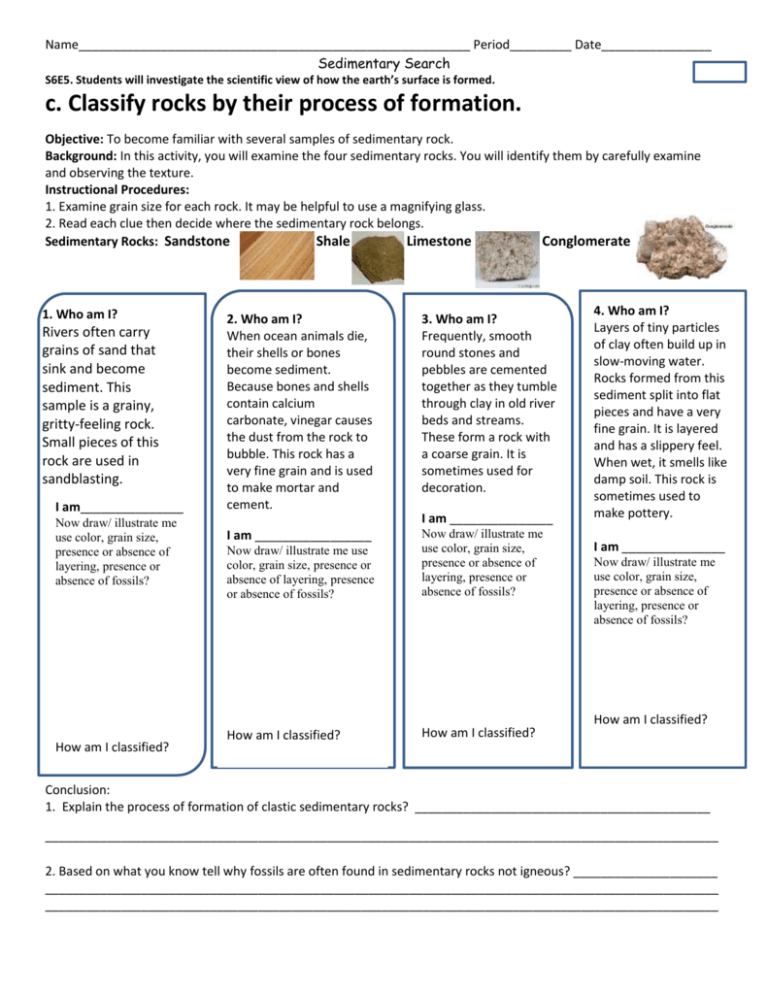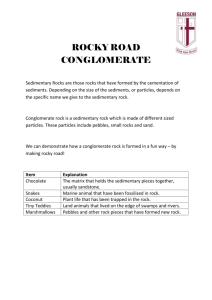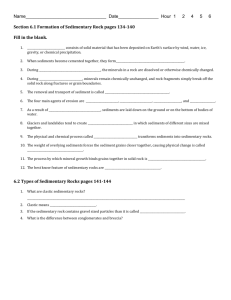File
advertisement

Name_________________________________________________________ Period_________ Date________________ Sedimentary Search S6E5. Students will investigate the scientific view of how the earth’s surface is formed. c. Classify rocks by their process of formation. Objective: To become familiar with several samples of sedimentary rock. Background: In this activity, you will examine the four sedimentary rocks. You will identify them by carefully examine and observing the texture. Instructional Procedures: 1. Examine grain size for each rock. It may be helpful to use a magnifying glass. 2. Read each clue then decide where the sedimentary rock belongs. Sedimentary Rocks: Sandstone Shale Limestone Conglomerate 1. Who am I? Rivers often carry grains of sand that sink and become sediment. This sample is a grainy, gritty-feeling rock. Small pieces of this rock are used in sandblasting. I am_______________ Now draw/ illustrate me use color, grain size, presence or absence of layering, presence or absence of fossils? How am I classified? 2. Who am I? When ocean animals die, their shells or bones become sediment. Because bones and shells contain calcium carbonate, vinegar causes the dust from the rock to bubble. This rock has a very fine grain and is used to make mortar and cement. 3. Who am I? Frequently, smooth round stones and pebbles are cemented together as they tumble through clay in old river beds and streams. These form a rock with a coarse grain. It is sometimes used for decoration. I am _______________ I am _________________ Now draw/ illustrate me use color, grain size, presence or absence of layering, presence or absence of fossils? Now draw/ illustrate me use color, grain size, presence or absence of layering, presence or absence of fossils? How am I classified? How am I classified? 4. Who am I? Layers of tiny particles of clay often build up in slow-moving water. Rocks formed from this sediment split into flat pieces and have a very fine grain. It is layered and has a slippery feel. When wet, it smells like damp soil. This rock is sometimes used to make pottery. I am _______________ Now draw/ illustrate me use color, grain size, presence or absence of layering, presence or absence of fossils? How am I classified? Conclusion: 1. Explain the process of formation of clastic sedimentary rocks? ___________________________________________ __________________________________________________________________________________________________ 2. Based on what you know tell why fossils are often found in sedimentary rocks not igneous? _____________________ __________________________________________________________________________________________________ __________________________________________________________________________________________________ 3. Deduce as much as you can about the area from which the sediment was derived, how it was transported, the environment in which it was deposited, and how it was lithified. Explain your reasoning. (Conglomerate) ______________________________________________________________________________________________ ______________________________________________________________________________________________ ______________________________________________________________________________________________ 4. Base your answer to the question below on the geologic cross section below, which shows a view of rock layers at Earth’s surface. The dashed lines connect points of the same age. Major fossils contained within each rock layer are shown. The valleys are labeled X, Y, and Z. In which type of environment were the sediments that formed these sedimentary rock layers most likely deposited? 1. 2. 3. 4. glacial mountainous marine terrestrial plateau Explain your choice.__________________________________________________________________________________ __________________________________________________________________________________________________ __________________________________________________________________________________________________ __________________________________________________________________________________________________ 5. Compare and contrast the sedimentary texture of sandstone and conglomerate. Which one do you think has sediment that was more greatly transported during its formation? ________________________________ __________________________________________________________________________________________________ __________________________________________________________________________________________________ __________________________________________________________________________________________________ 6. Create your own sedimentary rock and explain the process of formation? ______________









